This website may contain affiliate links and advertising so that we can provide recipes and guides at no additional cost to you. Learn more
Bring the aromas and flaky goodness that take so many Moldovans and Romanians back to childhood into your home kitchen with our sour cabbage pies recipe, or ‘plăcinte cu varză,’ and treat the family to a pastry that has been filling stomachs and warming hearts for generations.

Sour Cabbage Pies Recipe (Plăcinte cu Varză)
If a soft, flaky, golden brown pastry crust stuffed with a tangy sauerkraut filling sounds like your idea of culinary utopia, then you have very much come to the right recipe!
Plăcinte have been rolled, baked, and stuffed with an array of fillings for thousands of years, dating back to Ancient Roman times, and today these diverse pastries remain as popular as ever in Romanian cuisine and Moldovan cuisine.

What are Plăcinte?
Plăcinte are traditional Romanian and Moldovan baked goods, made from a flaky homemade dough, which can be stuffed with a range of sweet and/or savory fillings (see variations below).
Once the dough has been rolled and the filling placed on the dough, the pastries are either rolled into spiral or cylindrical shapes, coated in oil, and baked in the oven.
The pies are a hugely popular dish of both Romanian and Moldovan cuisine, and whether it be for a Sunday family gathering or an important holiday or celebration, pies are nearly always found on the dinner table in some way, shape, or form.
In fact, there are even plăcinte stalls and bakeries throughout Romania and Moldova that only make these warm, soft pastries with a range of different fillings, and nothing else.
Variations
Homemade vs Phyllo/Filo Dough Sheets – In our recipe, we have covered making your own dough. While not traditional, you could use pre-made phyllo/filo dough sheets, as making your own dough can be time-consuming. Check the note at the end of the recipe step-by-step instructions on how to use the store-bought phyllo/filo dough.
Spiral vs Roll – You will nearly always find plăcinte either rolled into a spiral shape or rolled into long cylinders and cut. The former takes a touch more skill but definitely has the wow factor when served on the dinner table.
Savory Fillings – Along with sauerkraut or sour cabbage, some of the most popular savory fillings include white cheeses native to the region, such as farmer’s cheese (tvorog) or telemea, or in combination with another ingredient, such as urdă, a ricotta-like cheese, and dill or spinach. Potatoes are also another popular filling choice.
Sweet Fillings – For sweeter pies, look for fillings such as apples, sour cherries, and apricots, among others.
Similar Style Pies in the Balkans – While not direct variations, similar pies and pastries, particularly rolled into spirals, are common in the Balkans, with arguably borek/burek, a staple of Turkish, Bosnian, and Serbian cuisine, among others, being the most common.
Recipe Ingredients
To make our sour cabbage pies recipe, you’ll need the following ingredients:

For the Homemade Dough:
- Flour* – 1 lb (450 grams) all-purpose/plain flour + 1/3 cup (50 grams) additional for kneading the dough
- Milk – 3/4 cup (180 ml) warm whole milk
- Sparkling Water – 1/2 cup (120 ml) sparkling water
- Salt – 1 tsp fine salt
- Yeast – 1 tsp instant yeast
- Sugar – 1/2 tsp sugar
- Sunflower Oil – 1/4 cup (60 ml) to add to the dough + 2 tbsp of oil when stretching the dough
- Egg – 1 egg yolk, for brushing the pies before baking them so they can be golden-brown
- Water – 1 tsp water to beat with the egg yolk for the egg wash
For the Cabbage Filling:
- Sour Cabbage (Sauerkraut) – 2 lb (900g) sauerkraut or sour cabbage (drained)
- Sunflower Oil – 1/4 cup (60 ml) for sauteeing the cabbage
- Black Pepper – 1 tsp ground black pepper
- Hot Paprika – 1/2 tsp hot paprika (or 1/4 tsp of regular paprika and 1/4 tsp of cayenne pepper)
Note: Try to pick the best all-purpose/plain flour you can. If you go for the cheapest flour, the pies will not be flaky and soft.
Step-by-Step Instructions
Step 1 – In a pan, over medium heat, add 1/4 cup of sunflower oil. After about 1 minute, when the oil is shimmering, add the drained sour cabbage (sauerkraut) and sauté for about 15 minutes until the cabbage softens.

Note: You want the cabbage to soften but not brown, so if it’s starting to brown, adjust the heat to medium-low or low accordingly.

Step 2 – To the sautéed sour cabbage, add the black pepper and hot paprika (or cayenne/paprika mixture) and mix well. Set it aside to cool down while working on the dough in the next step.


Homemade Dough Method
Step 3 – Combine the warm milk and sparkling water, and then add the yeast, mixing it in, then the sugar, and oil.




Step 4 – Combine the salt with 1 lb of flour and then add it to the milk-water-yeast mixture (1/3 of the flour at a time, while mixing with a spatula).




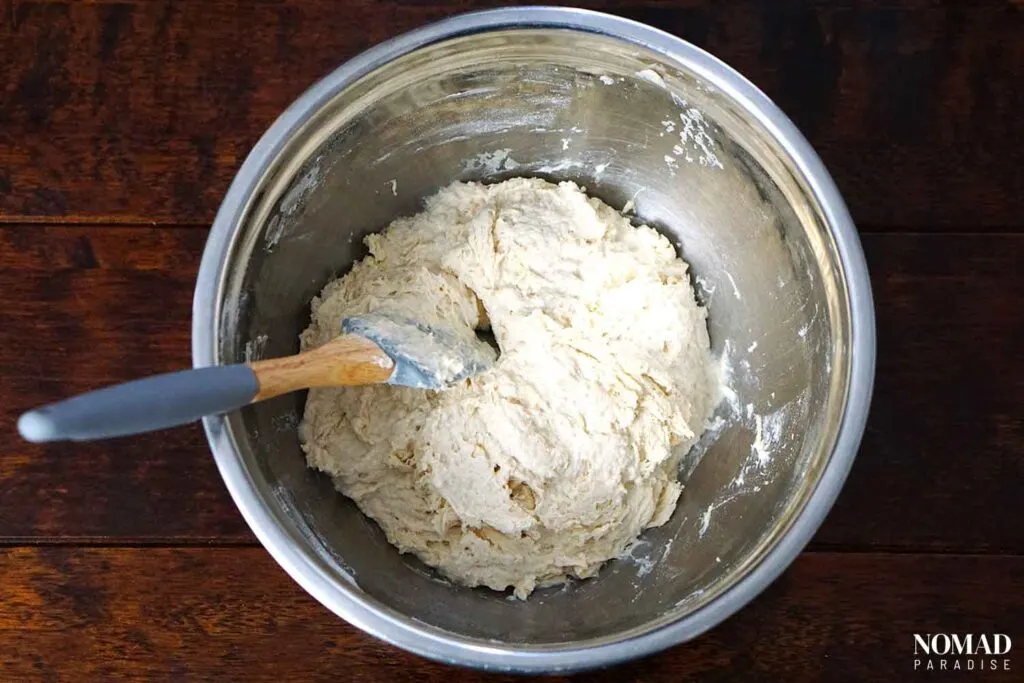
Step 5 – Knead the dough for about 5 minutes until smooth, adding 1 tbsp of flour from the extra 1/3 cup (50 grams of flour) at a time if the dough is too wet.
Note: We used up the entire additional 1/3 cup of flour while kneading to achieve the smooth dough pictured below, but you may not have to (as it depends on the flour you’re using and how wet/sticky the resulting dough is).

Step 6 – Put the dough in a well-oiled bowl and cover it with cling film (saran wrap) and a towel, and leave it to rest in a warm spot for 25 minutes.


Step 7 – Roll the dough into a cylinder and divide it into 6 equal parts, which you’ll make into round balls.

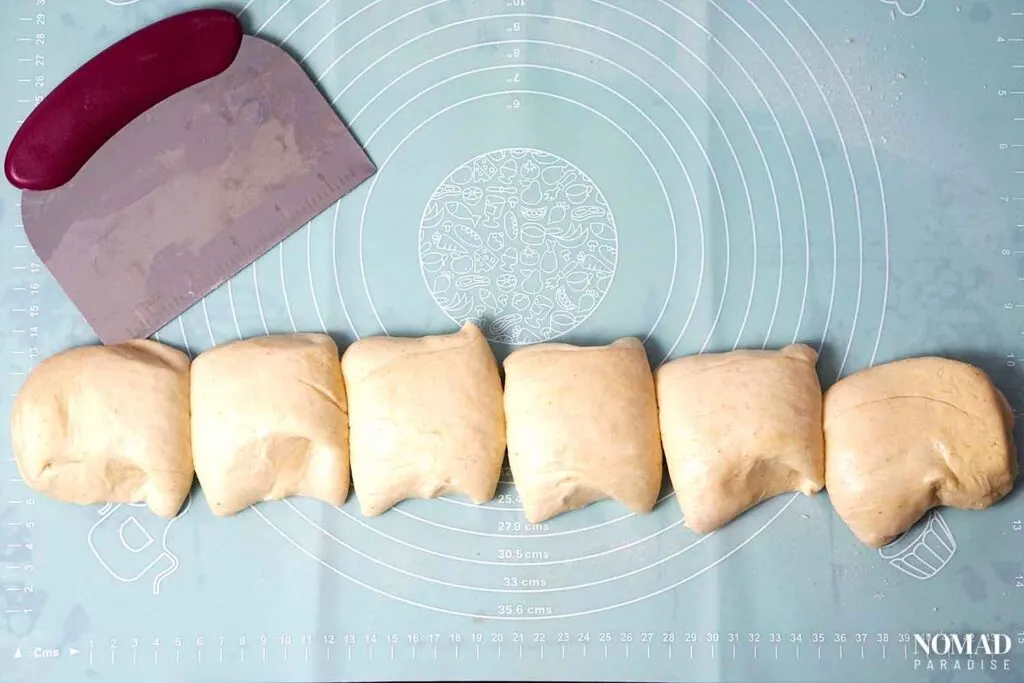


Step 8 – Oil the surface you’re using and your hands, and stretch out each ball of dough using a rolling pin and then stack them (brushing each layer with oil).



Step 9 – Now, stretch each round (one at a time) with your hands or a rolling pin until you have a very thin (see-through) square-shaped dough. Add sour cabbage/sauerkraut to the bottom 1/3 of the dough and then gently roll the dough over, forming a spiral/cylinder (pictured below).




Step 10 – Twist the cylinder around to form a spiral-shaped round pie.

Step 11 – Place baking paper over a cookie sheet/baking tray. Add the pies to them. Beat an egg yolk with 1 teaspoon of water and brush the pies with the egg yolk wash.


Step 12 – Bake in the preheated oven at 360°F(180°C) for 35-40 minutes until the pies are golden-brown and cooked through.

After removing them from the oven, cover them with a clean kitchen towel, and let them rest for about 10 minutes before serving them.

Note: Phyllo/Filo Sheet Method
If you want to skip making the homemade dough (which can be time-consuming), you can use phyllo dough. You’ll need about 3 phyllo/filo sheets per pie.
Brush the phyllo(filo) dough sheet with melted butter.

Add the second layer of phyllo/filo and brush with butter again and repeat with the third layer.

Add the sour cabbage mixture to half of the surface.

Roll the dough (on the short side). Add to the baking tray (covered with baking paper). Brush the pies with beaten egg yolk mixture and bake in the pre-heated oven at 360°F(180°C) for about 30 minutes until the pies are golden-brown and cooked through.


Once your pies are ready, plate them up and bring them to the table, so that everyone can dig in.

If you opt for the pre-made dough sheets, get ready to enjoy a soft, flaky rolled pastry that’s almost as delicious as its spiral counterpart.
Serving Suggestions
There’s no end to the options when it comes to these pies. While they can absolutely be enjoyed on their own as a snack or hearty lunch, warm or cold, consider some of these pairings:
Fresh Greens or Salads – Take a look at some of our salad recipes from around the world, and balance the filling pastry with refreshing greens, leaves, and chopped vegetables.
Wine – Savory pies are often served with red wine in Moldova.
Mici (Romanian Grilled Meat Rolls) – For a hearty spread you can serve the pies alongside mici.
Zacusca – Consider a side or dip, such as Romanian and Moldovan zacusca, or Balkan ajvar, to eat alongside these hot savory pies.
Filling-Specific – Naturally, think about the filling of your pies, and what would complement them. For example, if serving cheese pies, a side of pickled vegetables would add some acidity to the savory and salty notes of the pie. Whereas with this sour cabbage pie recipe, you’re better serving them with a fresh salad, as the sauerkraut already brings a lot of tang and acidity to the table.
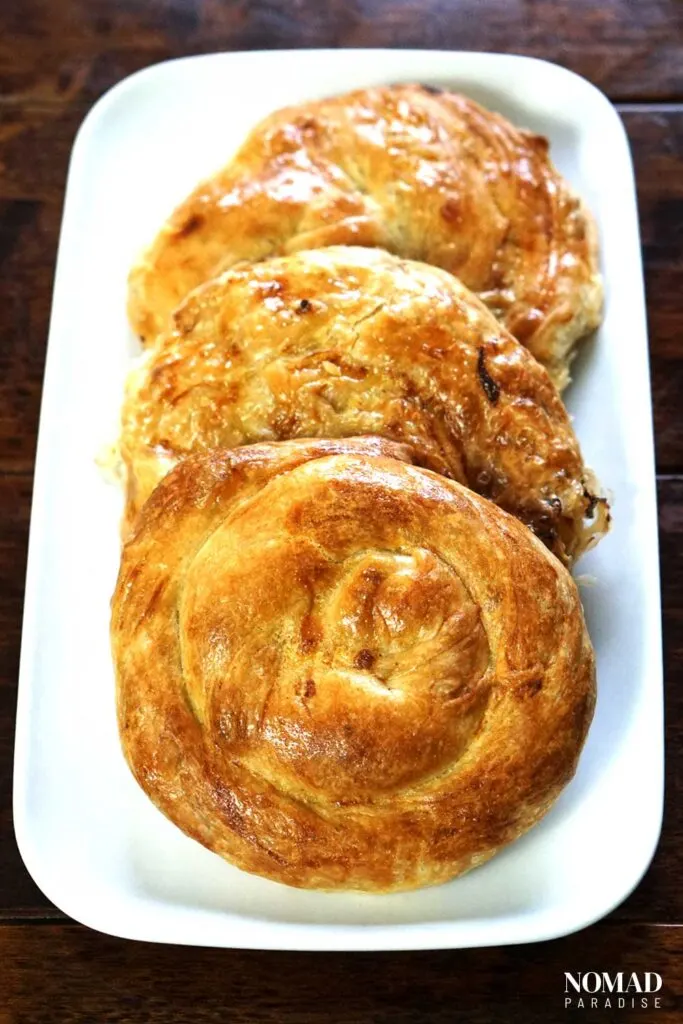
However you enjoy them, this truly is Romanian and Moldovan family food at its most nostalgic. I don’t know how many times I dined with my parents and extended family to a feast of pies and other beloved traditional dishes.
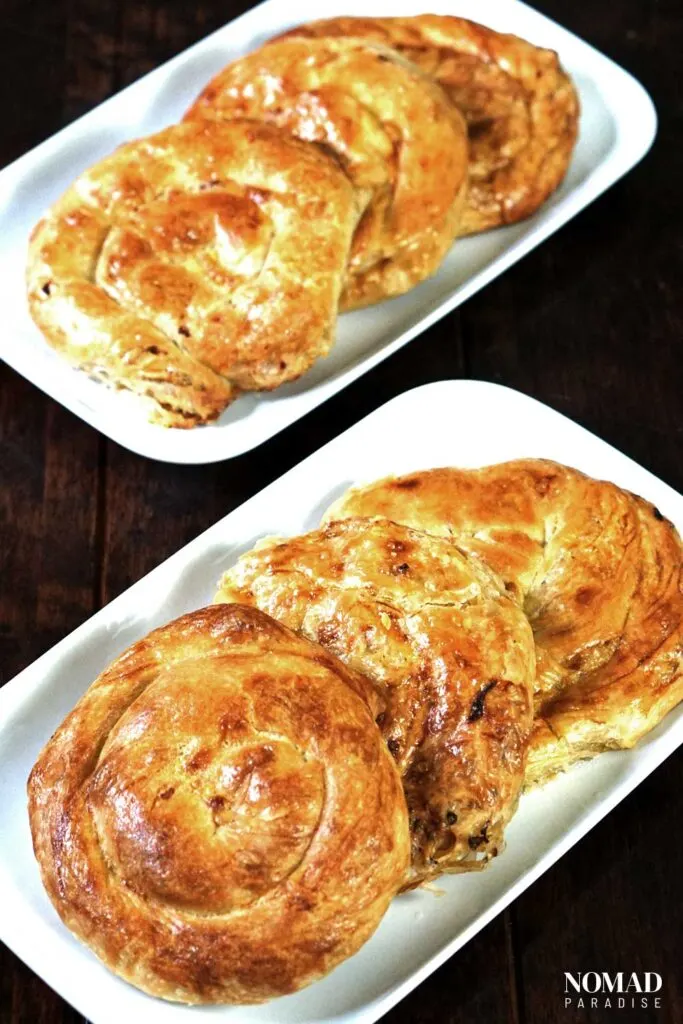
Sour cabbage pies bring back a lot of fond memories for me, and I hope you can bond with your parents, kids, family, and friends over soft, delicious pastries, such as these. If you decide to make them, let me know in the comments how it went!

Sour Cabbage Pies Recipe Card
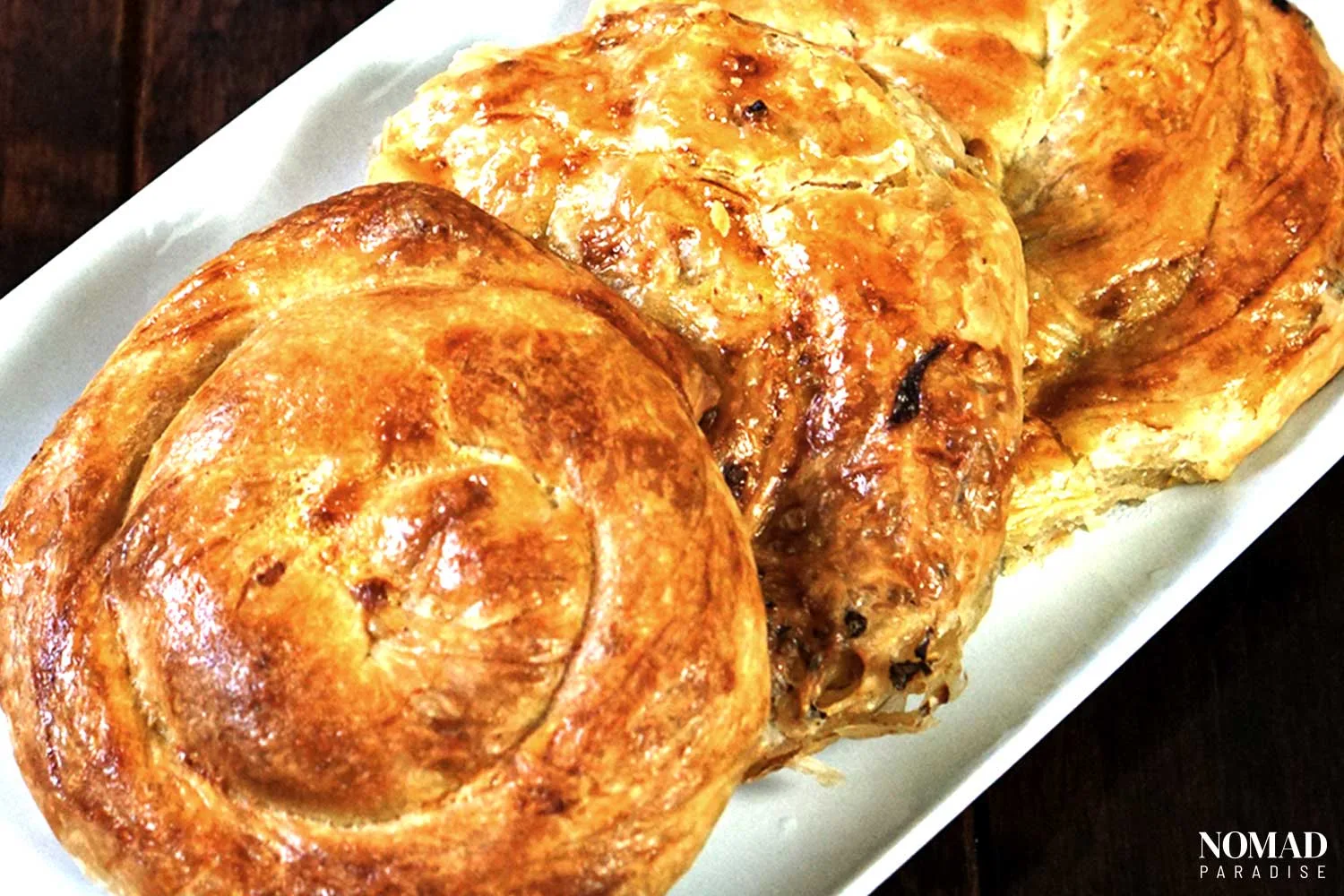
Ingredients
Homemade Dough
- 1 lb 450 grams all-purpose/plain flour + 1/3 cup (50 grams) additional for kneading the dough
- 3/4 cup 180 ml warm whole milk
- 1/2 cup 120 ml sparkling water
- 1 tsp fine salt
- 1 tsp instant yeast
- 1/2 tsp sugar
- 1/4 cup 60 ml sunflower oil to add to the dough + 2 tbsp of oil when stretching the dough
- 1 egg yolk for the egg wash
- 1 tsp water for the egg wash
Cabbage Filling:
- 2 lb 900g sauerkraut or sour cabbage
- 1/4 cup 60 ml sunflower oil for sauteeing the cabbage
- 1 tsp ground black pepper
- 1/2 tsp hot paprika or 1/4 tsp of regular paprika and 1/4 tsp of cayenne pepper
Instructions
- In a pan, over medium heat, add 1/4 cup of sunflower oil. After about 1 minute, when the oil is shimmering, add the drained sour cabbage (sauerkraut) and sauté for about 15 minutes until the cabbage softens. You want the cabbage to soften but not brown, so if it’s starting to brown, adjust the heat to medium-low or low accordingly.
- To the sautéed sour cabbage, add the black pepper and hot paprika (or cayenne/paprika mixture) and mix well. Set it aside to cool down while working on the dough in the next step.
- Combine the warm milk and sparkling water, and then add the yeast, mixing it in, then the sugar and oil.
- Combine the salt with 1 lb of flour and then add it to the milk-water-yeast mixture (1/3 of the flour at a time, while mixing with a spatula).
- Knead the dough for about 5 minutes, adding 1 tbsp of flour from the extra 1/3 cup (50 grams of flour) at a time if the dough is too wet. We used up the entire additional 1/3 cup of flour while kneading, but you may not have to (as it depends on the flour you’re using and how wet/sticky the resulting dough is).

- Put the dough in a well-oiled bowl and cover it with cling film (saran wrap) and a towel, and leave it to rest in a warm spot for 25 minutes.
- Roll the dough into a cylinder and divide it into six equal parts, which you’ll make into round balls.

- Oil the surface you’re using and your hands and stretch out each ball of dough using a rolling pin and then stack them (brushing each layer with oil).
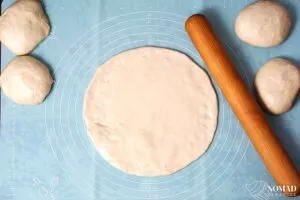

- Now, stretch each round (one at a time) with your hands or a rolling pin until you have a very thin (see-through) square-shaped dough. Add sour cabbage/sauerkraut to the bottom 1/3 of the dough and then gently roll the dough over, forming a cylinder (pictured below).




- Twist the cylinder around to form a spiral-shaped round pie.

- Place baking paper over a cookie sheet/baking tray. Add the pies to them. Beat an egg yolk with 1 teaspoon of water and brush the pies with the egg yolk wash.

- Bake in the preheated oven at 360°F(180°C) for 35-40 minutes until the pies are golden-brown and cooked through.
- After removing them from the oven, cover them with a clean kitchen towel, and let them rest for about 10 minutes before serving them.
Recipe Notes
- Try to pick the best all-purpose/plain flour you can. The pies will not be flaky and soft if you go for the cheapest flour.
- You could make these pies with phyllo/filo dough (although not traditional). See note in the article for the process and tips.
You Might Also Like to Read
- Mici / Mititei Recipe (Romanian Grilled Ground Meat Rolls)
- Romanian Chicken Soup with Sour Cream (Ciorba Radauteana)
- Banitsa Recipe (A Cheesy and Buttery Soft Pastry Dish from Bulgaria with Love)
Save and Pin for Later
Planning a large gathering or celebration? Keep our sour cabbage pies recipe for safekeeping by saving this article to one of your Pinterest boards.

Contributor: Efimia is a retired Moldovan teacher, who has been cooking a vast array of Eastern European dishes for family, friends, and loved ones from her home kitchen for over forty years and counting.
